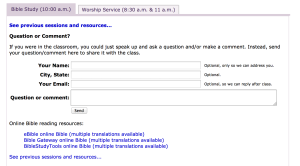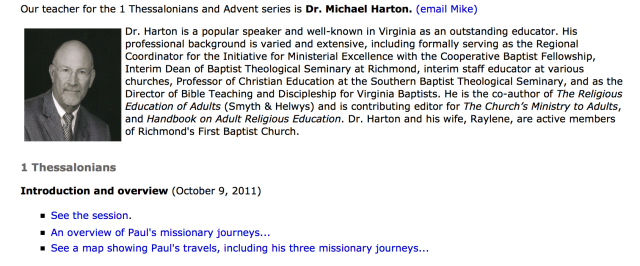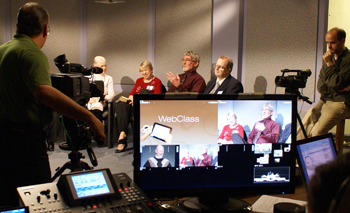Video on the web is the hottest thing in media today. According to YouTube’s own accounting,
- More than 1 billion unique users visit YouTube each month
- Over 4 billion hours of video are watched each month on YouTube
- 72 hours of video are uploaded to YouTube every minute.
Live video streaming is becoming more accessible with the introduction of new technologies, devices and hosts.
At Richmond’s First Baptist Church, we’ve been doing a live stream of our Sunday morning worship services for years. In October 2011 we started a live, interactive Sunday school webcast. We call it the WebClass Bible Study.
Since we appear to be on the “bleeding edge” with this concept, I’ve been getting a lot of calls about why and how we do it.
Why do we do it?
Three of the reasons people show up at a church building on Sunday morning are to worship God, study the Bible, and connect with other people. For those who can’t show up in person, the webcast of the worship service gives them a way to participate from another location. The WebClass provides a way for them to participate in a Bible study. And, in a limited way, it provides a way to interact with the teacher and other class members.
It is a way to push out the walls of the physical building and make these church activities accessible to more people… some of whom will never set foot in any church building.
How do we do it?
If you want technical details, go here.
 We have a page on our website with a video window and related materials for each week’s worship service and Bible study. When the webcast is “live” a big banner appears on our website home page, directing users to the webcast page.
We have a page on our website with a video window and related materials for each week’s worship service and Bible study. When the webcast is “live” a big banner appears on our website home page, directing users to the webcast page.
We try to make the webcast easily accessible. There’s no registration required. Users just go to the page and click on the play button.
![]() On the web page, there are two tabs: one for the worship service and another for the Bible study.
On the web page, there are two tabs: one for the worship service and another for the Bible study.
On the worship tab, there’s a copy of the Sunday bulletin, a place for comments, and, of course, a link for anyone who wants to make an online offering or contribution.
 On the WebClass tab, there are resources for the current week’s study, a bio of the current teacher, and a link to previous classes.
On the WebClass tab, there are resources for the current week’s study, a bio of the current teacher, and a link to previous classes.
We archive all of the sessions and resource material so if you miss a week, you can go back and catch up. And let’s say you have a small group in your home and you’re looking for a unit of study on, say, 1 Thessalonians. You could go to our archives and find an excellent unit of six sessions led by Bible scholar Dr. Mike Harton.
The WebClass is a coordinated effort by the Ministry of Christian Formation, led by Steve Booth, and the Ministry of Communication, led by me. Steve takes care of the content. I take care of the technology.
The two curriculum resources we use are found at FaithElement.com and NurturingFaith.net. Contact Steve for more details about the curriculum.
Early each week, the teacher publishes the study material. We post that material on the website for anyone who wants to do some advance preparation.
 When the WebClass is live, there’s a place on the web page to enter a comment or question. The comments go to an email inbox, which one of our crew members monitors during the class. She displays the message on a monitor and one of the onsite class members reads it aloud. That usually prompts responses from the teacher and other onsite and online participants.
When the WebClass is live, there’s a place on the web page to enter a comment or question. The comments go to an email inbox, which one of our crew members monitors during the class. She displays the message on a monitor and one of the onsite class members reads it aloud. That usually prompts responses from the teacher and other onsite and online participants.
The teacher uses an iPad for visual support. Sometimes it is a PowerPoint or Keynote presentation with a class outline. Other times it is a photograph, illustration or map. Using the iPad, the teacher may draw on the map or make notes as participants make comments. Everything on the iPad displays on a big TV monitor in the classroom.
Often, the teacher will use video clips to illustrate a point. Those clips are displayed on the video monitor, too.
 There are two cameras in the classroom. One focuses primarily on the teacher and the monitor. The other captures the onsite participants.
There are two cameras in the classroom. One focuses primarily on the teacher and the monitor. The other captures the onsite participants.
The director selects the appropriate camera, the video clip, or the iPad using a video switcher.
The audio technician controls the lapel microphone for the teacher and the overhead shotgun microphones, which pick up the comments from onsite participants.
Who participates?
A core group of 8-10 folks make up the onsite class.
There are several members of our congregation who travel several months a year. On Sundays, they are able to connect via the webcast and get a little taste of home from the road.
On a recent Sunday, one of the regular online participants who lives near Richmond asked about another regular participant who lives in southwest Virginia. She hadn’t heard any comments from him in recent weeks. She wondered if he was OK. Think about it. They’ve never met, and neither of them has ever set foot in the church building. The only connection they have is by hearing each other’s comments and questions during the WebClass. But a sense of community has developed over the months. So the handful of people in the classroom and the couple of dozen online participants feel connected to each other.
Not long after we started the WebClass Bible Study, we heard from a lady in Oklahoma who was hospitalized, awaiting an organ transplant. She participated in the WebClass via her iPad from her hospital bed every Sunday morning. It was the only way she could participate in worship and Bible study. I’m sad to say that she died earlier this year. And all the WebClass participants, both onsite and online, grieved with her family.
We’re finding the live webcast an effective way to remove the walls of the church and let folks participate wherever or whatever their location or situation.
Here’s an article by Steve Booth in First Things First on how the WebClass provides a “safe place for people to ask honest questions about a biblical text.”
Here’s an article about the WebClass by Robert Dilday of The Religious Herald.

